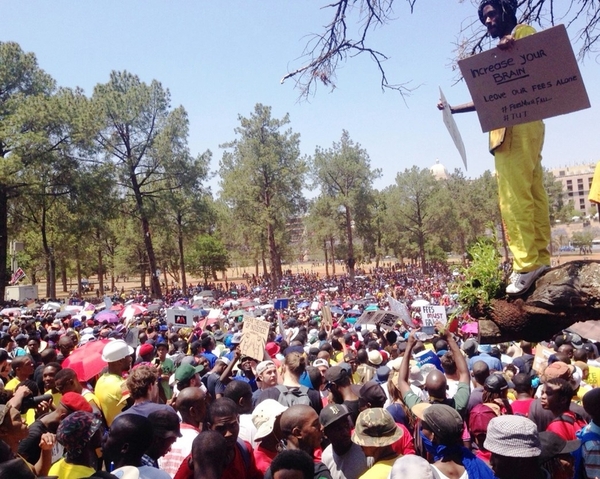

Many thousands of protesters gathered at the Union Buildings in Pretoria today. Photo by Juliette Garms.
23 October 2015
From Pretoria to East London, from Cape Town to Stellenbosch, and even in London, students and their supporters demanded a zero percent increase to fees. But while most of the protests were peaceful, at UWC and Pretoria protesters and police clashed.
Many thousands of protesters marched from Burgers Park to the Union Buildings in Pretoria at 11am this morning. They filled the grounds in front of the Union Buildings almost to capacity. Most sang and danced peacefully, although some set fires, doused by police with water cannons.
There were several skirmishes in which police fired rubber bullets and tear gas at a small group of demonstrators after rocks and sticks were thrown. Students in the front of the crowd called for discipline as a few others tried unsuccessfully to break the gates.
“All the political parties are in front performing for attention,” said Lebo Makola, a BComm student at the University of Pretoria. “There’s the ANC, EFF and SASCO — it’s a mess.”
Lawyer Caroline James stood by with colleagues ready to assist protesters in case there were any arrests. “Apart from a few isolated incidents, we’ve witnessed a very peaceful gathering here today,” she said.
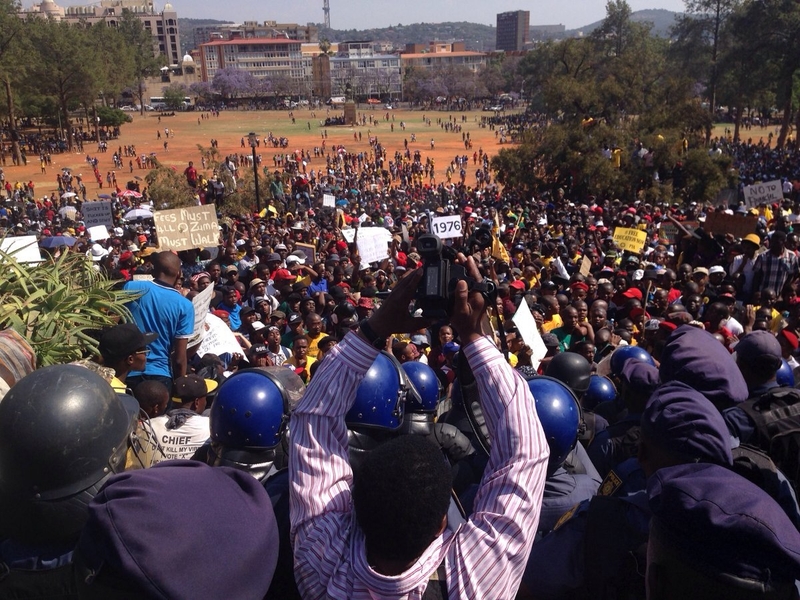 View of protest at Union Buildings. Photo by Juliette Garms.
View of protest at Union Buildings. Photo by Juliette Garms.
Eventually, the grounds were all but emptied at around 2:30pm when more teargas was dispersed further into the crowd. But people trickled back quickly to wait to be addressed by President Jacob Zuma who was meeting student leaders and university management.
The afternoon culminated in chaotic confrontations between police, media and protesters. After President Zuma announced that there would be no fee increases, police descended on the lawns of the Union Buildings to clear out the celebrating students using Nyalas, teargas, rubber bullets and water cannons. Clashes continued on the streets near the buildings as students blockaded Stanza Bopape Street with rocks, bricks and sit-ins. Some also threw rocks at police vehicles. At least three people have been treated for injuries by paramedics.
Former GroundUp staffer Daneel Knoetze, who was at the Union Buildings protest, said, “The dispersal of students by SAPS at the union buildings was premeditated, completely unprovoked and preceded by at least an hour of calm and peaceful waiting for an address by Jacob Zuma.”
Meanwhile, the empty Union Buildings lawns have been reduced to smoldering fires.
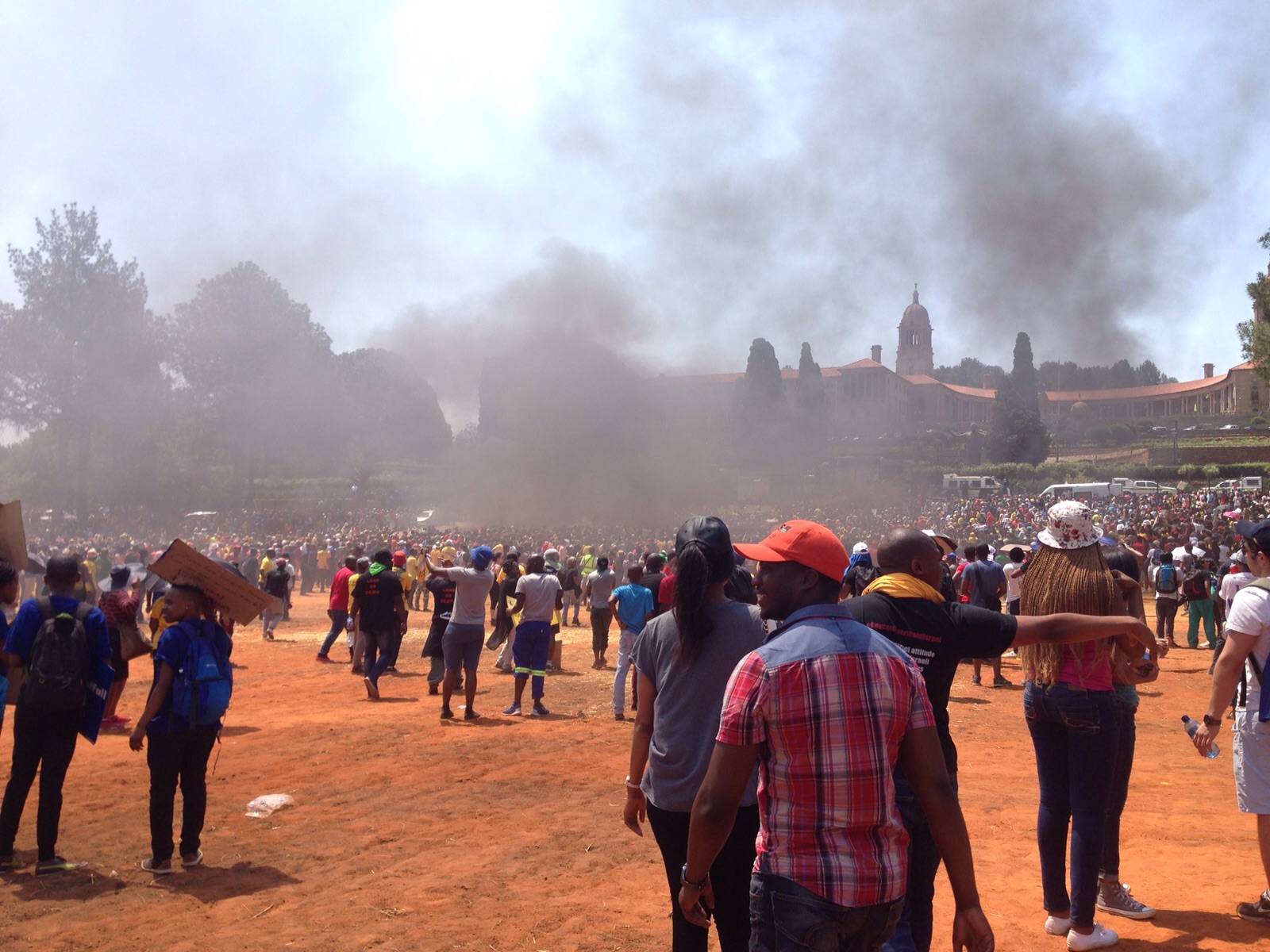
Smoke from police action at Union Buildings. Photo by Juliette Garms.
Yesterday, represented by the Legal Resources Centre (LRC), ten protesters who were at the march to Parliament on Wednesday reached an order of court settlement with the Speaker of Parliament, Minister of Higher Education, Minister of Police and Western Cape Provincial Commissioner of SAPS. Lara Sauerbier, a candidate attorney with the LRC described the applicants as “student protesters who were either assaulted or witnesses to events at Parliament”.
In the court order, the applicants agreed to abide by the Gatherings Act and “respect the National Key Points”. The police respondents in turn “undertook not to use unreasonable force to disperse and/or police peaceful gatherings and/or demonstrations, relating to tuition fee increases …”.
The court order was handed out at protests today, and shown by the students to police if they were concerned that excessive force might be used.
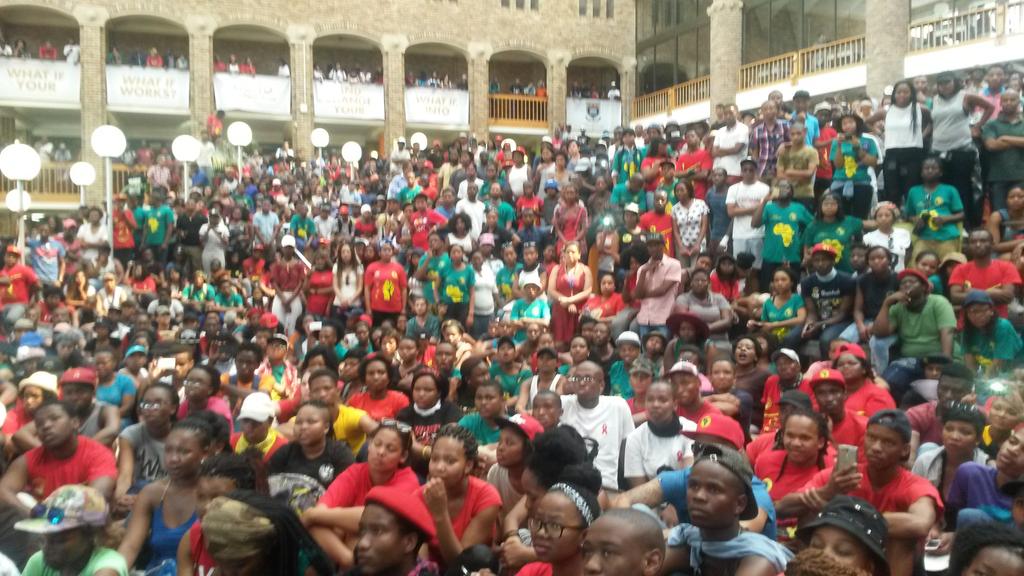
Students at UWC protest this morning. Photo by Ashleigh Furlong.
In the late morning, University of the Western Cape students gathered at the student centre and sang while they waited for rector Tyrone Pretorius. Barricades were erected. There was some confusion when students from Cape Peninsula University of Technology arrived. The rector made a speedy exit.
He then returned when things settled down. The rector said he had not attended the meeting with the President as he needed to speak to the students.
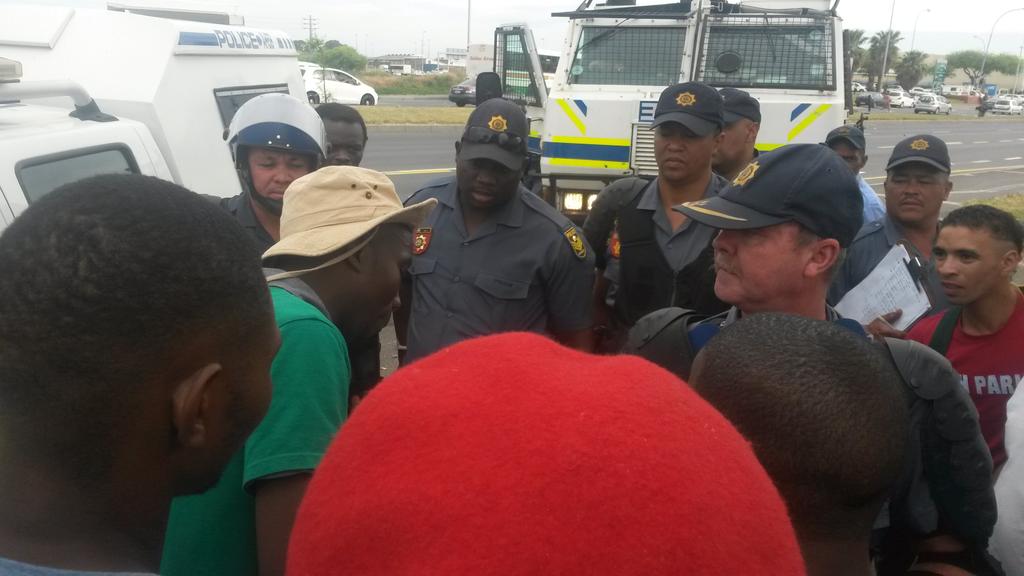
Protesters show police the interdict that prevents unnecessary force.
After this the students began to march from UWC to Cape Town International Airport. When they got to Bishop Lavis, riot police who arrived in Nyalas fired stun grenades, teargas and water cannons at the students. Protesters initially dispersed into side streets, but when the police stopped firing at them, they came together on a field between flats and houses. Many people emerged from their homes and stood watching the students as they stood with their hands in the air. Police announced that the gathering of the students was illegal and that they had five minutes to disperse or “action will be taken which might include force.”
A police officer asked “all innocent bystanders” to go into their homes, especially children as the police might use force. Student leaders then approached the police with the interdict they obtained yesterday. No agreement could be reached, and the police once again announced that the protesters had five minutes to disperse. Police once again threw stun grenades and teargas as a police helicopter circled overhead. Students ran into Bishop Lavis. It appears the police then followed large groups of students to ensure that they dispersed. Once matters calmed down one of the student leaders approached the police and asked if the protesters could be escorted back to UWC as they did not want to face further violence from the police if they assembled as a group. This was agreed upon.
It is not entirely clear why students wanted to march to the airport, but one protester told GroundUp that they wanted to stop all public services. When a few protesters were informed that President Zuma had announced a zero percent fee increase, they replied “We don’t care,” intimating that they wanted a reduction in fees, and not just a zero percent increase.
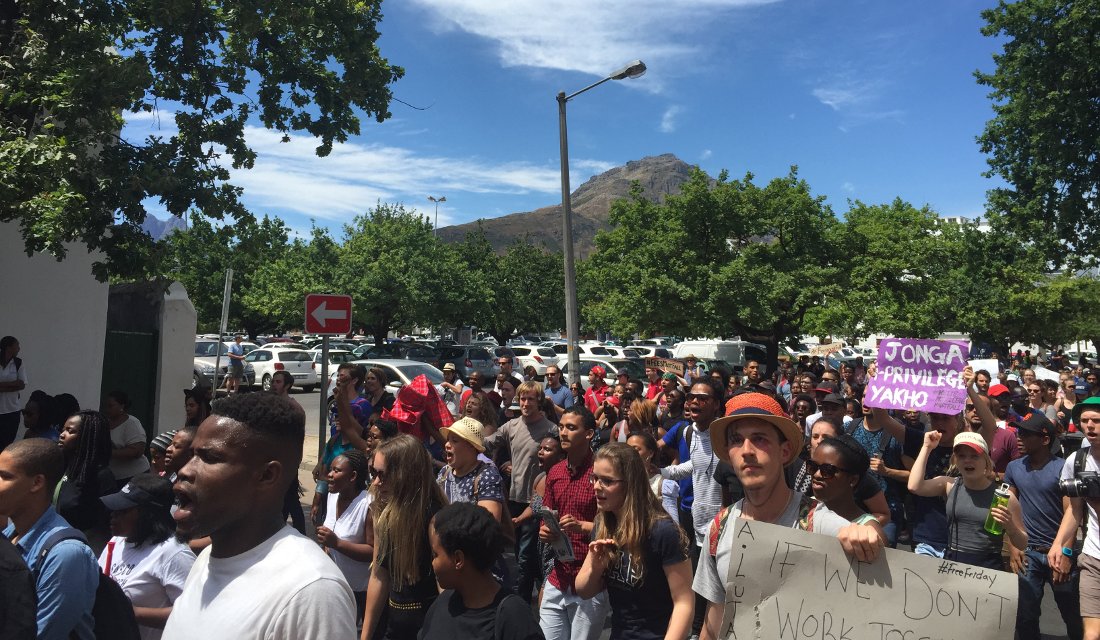
A diverse group of Stellenbosch university students marched through the university town. Photo by Amy Trout.
As of this morning, Stellenbosch University was not formally shut down with lectures and some exams still attempting to take place. Thousands gathered at the university marching from building to building, shutting down campus.
Students have been calling for Stellenbosch management to talk to them all week. At one stage management came to the march but students insisted that management meet them in the Merriman intersection — this was communicated via Facebook.
Once in the Merriman intersection, the university management was called and asked to sit down, which they did.
Faith Pienaar, chair of the Stellenbosch #FeesMustFall, explained that earlier in the week, while students were attempting to have a peaceful sit-in, the university had evacuated the students and obtained a court interdict against the protesting students.
Pienaar demanded answers to the following questions: Will the interdict be lifted? What is management doing about the fee increase? Will exams be postponed?
Professor Wim de Villiers, Vice Chancellor of Stellenbosch, was given an opportunity to speak but also reminded by students to not digress and to simply answer their questions. De Villiers said that Stellenbosch had been shut down. He said that management was behind the call for a 0% fee increase. He also said that he was proud of the Stellenbosch students for having peaceful protests and that the interdict would be lifted immediately. On exams, he claimed that there would be an opportunity to write second option or third option papers, but the exam schedule would remain the same. Students insisted on a week postponement.
Pam Dhlamini from UCT explained to the crowd that UCT students had managed to get a court interdict against the police to not use excessive force when dealing with unarmed student protests.
She also reminded students to not provoke the police in any way, since this might jeopardise the hard won interdict and students arrested after provocation would be on their own.
Dhlamini called for solidarity among students across the province and the country saying, “We only have each other, we must stand together, that’s the only way we are going to win this feesmustfall.”
Video report by Lucilla Blankenberg of today’s events at Stellenbosch.
Michaelis campus was blocked off since last night with bushes and black wattle tree branches.
Cars also blocked off the entrance to the Baxter theatre this morning.
In the morning, academics marched with a set of demands for the university administration.
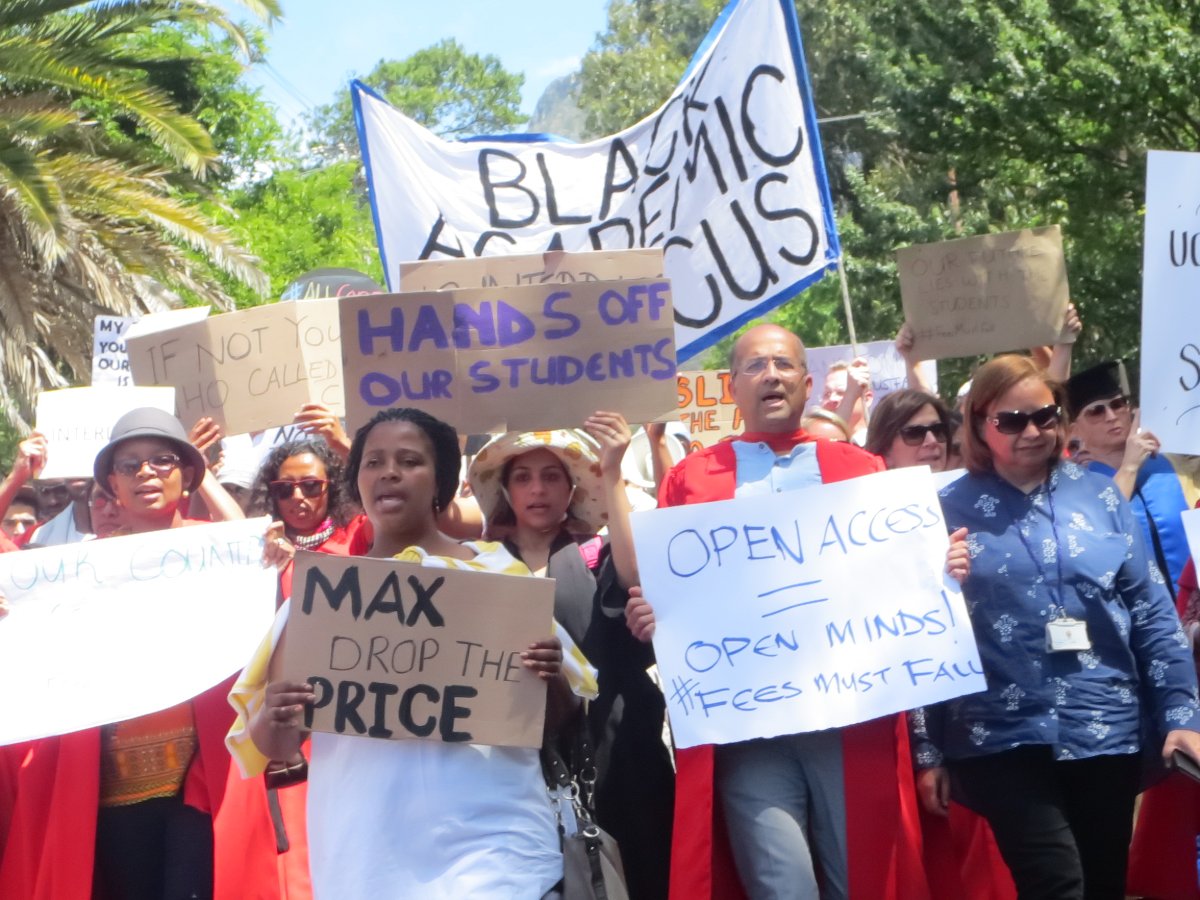
Academics marched to UCT’s administrative buildings. Photo by Tariro Washinyira.
Students marched from Walter Sisulu University’s Buffalo City campus to East London’s city hall. Later in the day police dispersed students. At least one student was arrested.

Students marched to the City Hall in East London before they were dispersed by police. Photo by Siphesihle Matyila.
About 250 to 500 people protested in Trafalgar Square, London, outside South Africa House in support of #FeesMustFall. Among the posters and banners were “Blade are you too blunt to cut fees?” and “No to police brutality’
The South African High Commissioner at first refused to sit with the students and demanded a chair. Eventually he sat down on the floor to the appreciation of the crowd. He then listened to the memorandum being read out, signed it, and left.
One protester was arrested. An eye witness told GroundUp that two protesters sat on window sills in the embassy. The police tried to arrest them. One of the protesters didn’t resist, and was subsequently released when the crowd chanted for the police to let him go. But the other protester tried to flee and was apprehended. He was still in police custody at the time of publication.
Protesters in London chant in support of the call for fees to fall. Video courtesy of Gilad Isaacs.
Also see this seven minute video of the London event on Facebook, showing the interaction with the South African High Commissioner.
Text for this report from Yumna Mohamed, Juliette Garms, Ashleigh Furlong, Siphesihle Matyila, Tariro Washinyira and Lucilla Blankenberg.